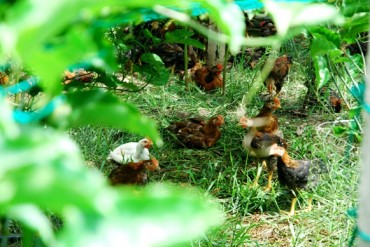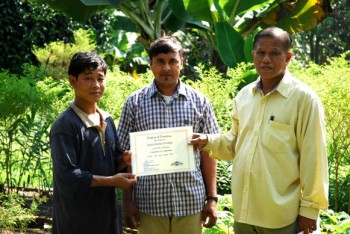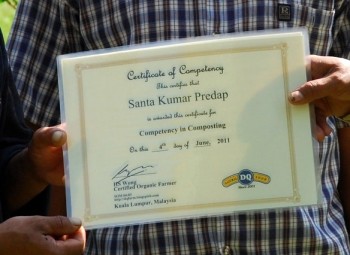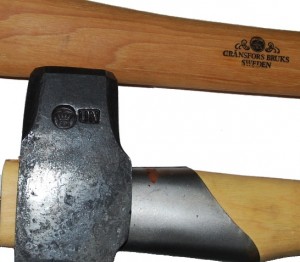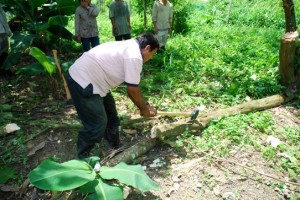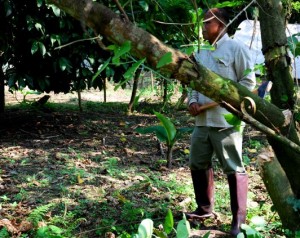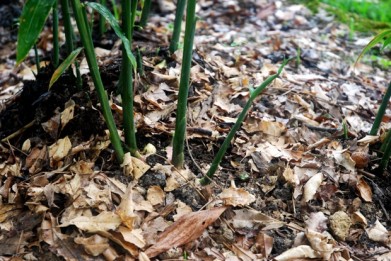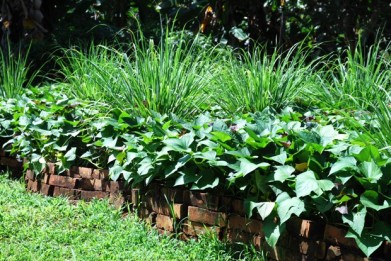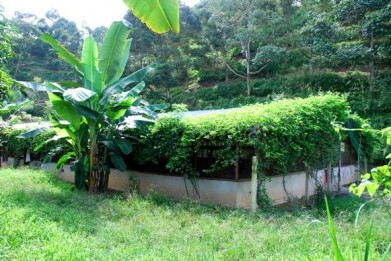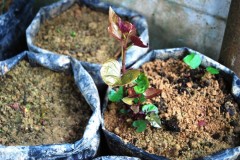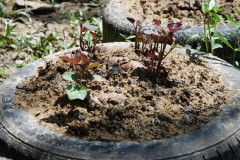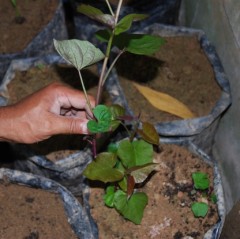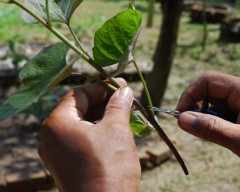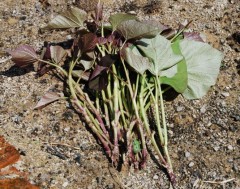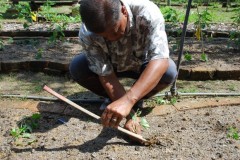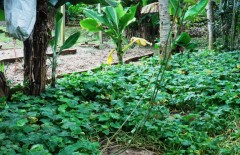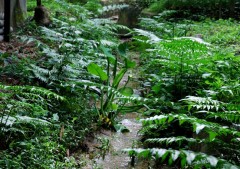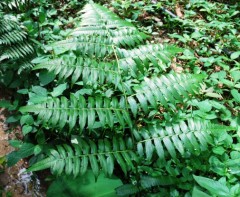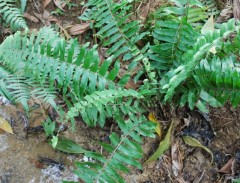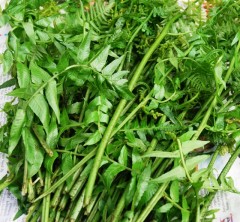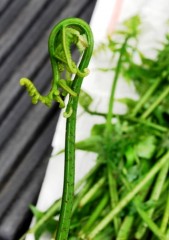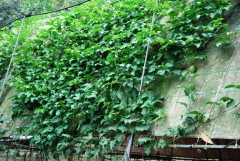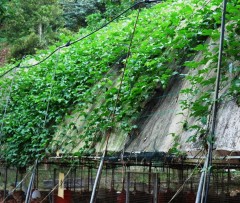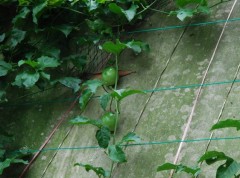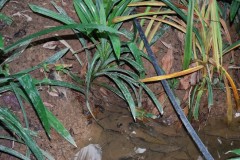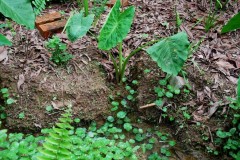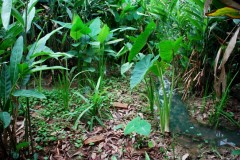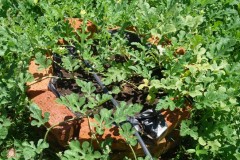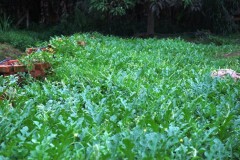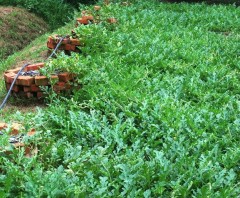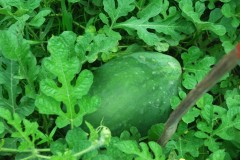Aug 03, 2011
Free Range Chicken - Natural Sun-Shading I
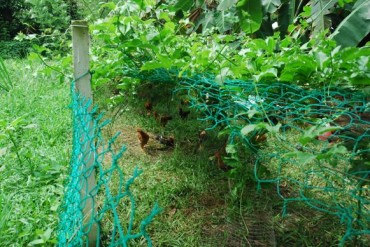
This Ramadan sure is hot. For the watermelon seller, bad sales surely is not his lot. The chickens listlessly loll. Under the markisa shelters. Aren't we glad we had tolled. These lovely markisa all to enjoy.
Yesterday was 40 celcius. Hot enough for these chickens to drop dead from heat stroke. And we are talking about ayam kampung, tough as nails!
Natural sun shading used in the farm includes these passion-fruit vines and clumps of big-leafed pisang sematu. Remember, bare earth retains and reflects heat. Bare earth patches can be 5 celcius higher than grass covered patches. And all water-lines MUST be protected from the sun.
A friend of mine is running a closed-house farm. He is cursing day-and-night over his energy bills.
Selamat berpuasa.
10:20 Posted in Chickens, Permaculture | Permalink | Comments (1) | Tags: permaculture, free range chickens, sun shading, passion fruit, markisa, ramadan
Jun 05, 2011
Spreading the word....
Our workers come from distant villages in the Himalayas. They come of course to earn much needed hard cash. But more than that we make sure they return home with new knowledge and skills to increase productivity without resorting to chemicals. When they achieve competency in a specific area, they get a certificate. Our farm have a long list of Nepalese who want to work for us.
Here's Santa Kumar receiving his competency certificates from Pak Cik Razaly the farm manager. Looking on is the farm supervisor, Dilli Prasad.
Santa received his certificates in composting and in marcotting.
He showed that he could independently produce compost on a schedule so that supply is never cut off. He could ensure that temperatures are reached so that pathogens are destroyed. He always gets the carbon: nitrogen ratio right.
Certificate in composting
He does marcotting of fruit trees independently with no supervision and has close to 100% success.
Certificate in Marcotting
We award certificates for competency in a wide range of farm work – from taking care of specific crops, for example, sweet potatoes, spinach, etc., to making high quality cement posts, to poultry necropsy and disease identification.
When they return to Nepal, they can either be better farmers, or they can use the certificates to train others or to earn better wages from their next employer.
08:56 Posted in Blog, Permaculture | Permalink | Comments (2) | Tags: training, certificate in organic farming, dq farm, knowledge based farming
May 27, 2011
A Good Axe is also Permaculture?
A quality durable axe, quaranteed for 20 years will mean "we take less, that we need to produce less, destroy less". That's permaculture! That's the antithesis to modern unsustainable consumer driven economy (think branded running shoes that lasts only a few months).
We received these axes which are quaranteed for 20 years, recently
These are from Gransfors Bruks, Sweden. The quote above is from their Axe Book. Permaculture in Manufacturing - PermaFacture perhaps!
We got a splitting maul, a splitting wedge, and a felling axe.
The axe-smith who made our axes is UN or Ulrik Nilsson. Here's his picture from the Axe Book:

We took the axes for a test recently. The Nepalese who are regular axe users say they are the best axes they have ever used in terms of balance, conservation of energy, etc.
Pak Cik Razaly had an interesting question: why can't we make such axes? Why indeed.
Dilli, our Nepalese supervisor, trying out the maul.
Pak Cik Razaly felling this 8 inch trunk without breaking a sweat. Have you tried a China-made axe?
Thanks to Lrong Lim in Takamatsu, Japan for writing about his Gransfors Bruks axe in his blog: http://lronglim.blogspot.com/
This is Gransfors Bruks' website: http://www.gransfors.com. Email is yxboken@gransfors.com.
P.S. The axes took 5 days to arrive in KLIA from Sweden (after waiting a couple of months for them to be forged). They took 9 days to travel from KLIA to our office in KL, a distance of 50 km.
16:35 Posted in Blog, Permaculture | Permalink | Comments (4) | Tags: grunsfors axes, lrong lim, american felling axe, splitting maul
Apr 13, 2011
Permaculture At The Farm II
Here are more examples of permaculture (permanent agriculture) at the farm:
Mulching to reduce water loss. Previously we advocated sheet mulching (to reduce weeds, etc ) with cardboard and other cellulose based material. DON'T DO IT! Termites love these heavy cellulose material. Mulching in humid Malaysia should be light to avoid termites and fungal problems. Leguminous cover crop as living mulch is a better idea.

Multi-crop and companion planting of gingers, chilies, sweet potatoes, water melon and passion fruits on raised beds. Permaculture is antithetical to mono-cropping (think oil palm, or think dragon fruit farms; organic or otherwise). On a small farm level, mono-cropping often leads to increasing dependence on chemicals and crops are often decimated suddenly by disease. The recent demise of many dragon fruit farms, both conventional and organic, is one example.
Serai or lemon grass on raised beds with sweet potato as living mulch and companion. Once the sweet potatoes are harvested, leguminous cover crop will be planted to revitalise the soil.
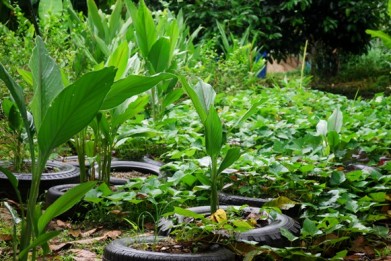
A low maintenance food garden grown entirely on used tires on low yield soggy, clayey soil. Practically no weeding is needed and monthly dressing of compost is all that's needed to produce sweet potatoes, curcuma mangga, lempoyang, kunyit and common ginger.
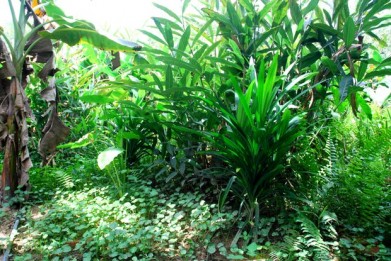
A 3000 sq ft food forest with very low maintenance, fed by a grey water treatment pond, producing taro, banana, papaya, pegaga, lengkuas, pandan, misai kucing, geranggau and other herbs. It provides a rich habitat for wild birds, eels, haruan, sepat, frogs, butterflies, insects, snakes, etc. It is one of our favorite spots in the farm. However, not everybody likes the overly 'friendly' snakes ( we counted 7 species so far ).
Under the traditional Asian chicken coop (on stilts), in-situ composting ( with the aid of farm-brewed IMOs ). This reduces human energy ( in having to remove the dung after every cycle). Removal of the composted material is done once every 8 months or so, and goes straight to the durian trees.
More examples of sun shading using plants - passionfruit, banana ( sematu, as it can reach 20 feet or more, high) and gliricidia septum.
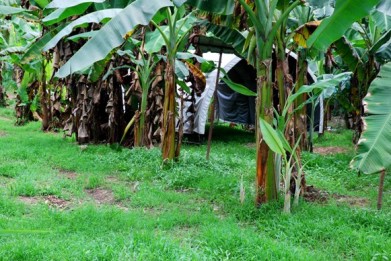
Integrating animal husbandry with fruits - here, free range chickens with bananas. There is no necessity to fertilise the fruit trees at all. Do not integrate durians with chickens.

Sematu is best - it has large leaves providing good shade, grows fast and is more hardy than 'improved' bananas like mas or berangan. The sematu above are young trees, barely three months old.

Free range chickens with mangosteen - here, hiding from the mid-day sun under the mangosteen fruit trees.
17:21 Posted in Permaculture | Permalink | Comments (2) | Tags: permaculture, free range chickens, sun shading, grey water treatment, integrated farming, permaculture examples, raised beds, companion planting, mulching, sheet mulching
Mar 14, 2011
Permaculture At The Farm I
Here's some permanent agriculture (permaculture) features at the farm:
Alley cropping of napia grasses to reduce pressure on arable land for ruminants. By cultivating grasses we can raise up to 200 goats per acre of land versus around 15 here in Malaysia. We alley crop with nitrogen-fixing leguminous gliricidia septum. It may be necessary to fallow with leguminous cover crops after a couple of years. At the moment, we ferment chicken discards such as feathers, guts, etc. to produce a liquid fertiliser, and fertilise twice a year. So far, production of grass has been maintained, a good example of sustainability.
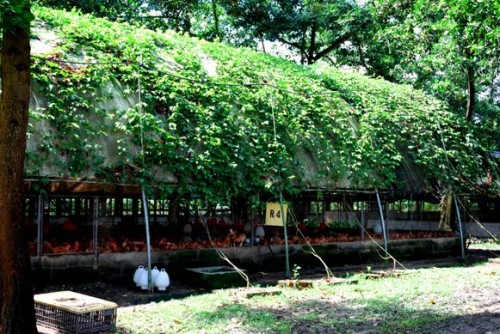
Passion (fruit) vines grow fast, and produce sufficient foliage to impart noticeable cooling. Sun-shading using plants is efficient, easy, with little maintenance needed, and have practically no running costs. Next, passiflora shades in the chicken fields; side effects - more insects and vitamin Cs for the chickens!
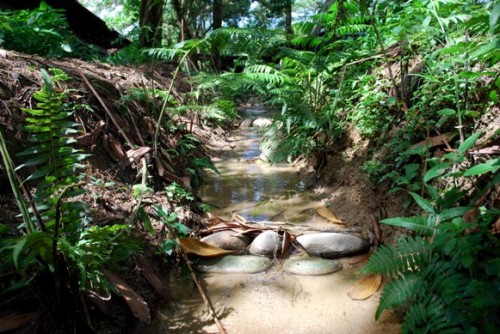
Earth drains permit infiltration of water and generally slows down run-offs. However, in our heavy monsoon downpours, earth drains need regular maintenance and may contribute to erosion.
A judicious mix of earth and concrete drains may be necessary, in addition to other water retention and diversion strategies.
Earth drains increase available planting spaces in small farms. Earth drains at our farm are income generating, producing a variety of crops - watercress, edible ferns, pandan leaves, arrowroots, and various edible taro tubers.
The picture shows the laying of low stone barriers across earth drains to slow down water flow and hence reducing erosion. They also allow for deeper, slower flowing sections enabling feeding and hence increasing the population of wild eels which are harvested.
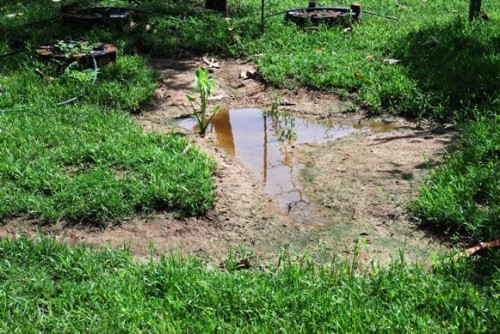
Shaping of land to create catchment areas to retain water, to slow down flow of rain water, and in the case in this picture, to reduce water-logged areas. In the process planting spaces are created for growing water loving vegetables - here, just planted watercress and arrowroot.
After a down pour, the land used to get soggy and difficult to work for days. With these catchment areas, the soggy areas are gone and the catchment area retains water for weeks (due to high water table) - good for planting income generating water loving vegetables.
12:03 Posted in Permaculture | Permalink | Comments (2) | Tags: permaculture, napia grass, sustainable agriculture, organic farming, natural sun-shading, passion fruits, swales, earth drains, retention ponds
Jan 17, 2011
Sweet Potatoes for the beginner organic farmer
Sweet potatoes are ideal for the beginning organic farmer and the beginning permaculturist. It is an undemanding crop and do not require high nitrogen inputs ( which equal to less costs and less disease problems).
If you are trying to earn some extra cash, then grow the purple colored varieties as they fetch a higher price and is always in demand (because of its higher antioxidant content). Organic shops will buy them off you anytime.
To grow them, start a nursery with tubers ( of the quality and variety you want ) as follows:
This one uses a conventional black nursery poly bag.
Here we use discarded tyres from tyre shops at no costs.
Instead of a nursery, you can also use cuttings from fully grown vines from existing sweet potatoe patches (so long as you know the quality).
When the shoots or slips, as they are called, are about 8 inches long, snip them off and plant to soil.
The slip is snip off to plant. The tuber will continue to provide slips for months.
Snip off the lower leaves before planting.
Bunch of slips
Insert the slip into the soil at an angle using a bamboo or a piece of wood.
A planted bed.
Raised beds are preferred. Use sandy soil. Do not fertilise with high nitrogen fertilisers such as chicken dung. Use vermicast, compost or humus. Sweet potato is ready for harvest in 4 months (depending on variety).
The home gardener or small-scale farmer can start a nursery in one tyre and then plant individual slips in seperate tyres as follows:
Planting in tyres as raised beds to make use of land with bad clayey soil at the farm (click on pic for close up)
Each tyre will then produce one crop of sweet potatoes and you harvest as and when you need them.
At our farm, we also plant sweet potatoe as a living mulch:
10:38 Posted in Permaculture | Permalink | Comments (0) | Tags: sweet potato, ipomoea batatas, purple sweet potato, slips
Jan 10, 2011
Edible Ferns
Edible ferns have been enjoyed for thousands of years by rural folks. It is now making its way into gourmet restaurants and urban kitchens. If your farm have earth drains, then edible ferns can be an extra source of income with almost zero costs. Just make sure that your water source is pristine as ferns are good absorbers of heavy metals.
This one, diplazium esculentum
Not this one. Note the difference in the branching.
Edible fronds and young leaves.
Edible fronds
Edible ferns are delicious stir-fried with sambal belacan, or just dried anchovies, or plain garlic.
09:43 Posted in Permaculture | Permalink | Comments (2) | Tags: edible ferns, paku pakis, pucuk paku, diplazium esculentum, fiddleheads
Dec 24, 2010
Energy Free Cooling (Sun Shading For Rebans)
West side sun shading leading to energy free cooling via passion fruit vines at our farm:
Plastic coated wires to act as support for the vines.
External ambient temperature, 38 celcius at 2 to 3pm. Under the passion fruit shade, 31 to 32 celcius.
18:15 Posted in Blog, Permaculture | Permalink | Comments (0) | Tags: energy free, sun shading, passion fruits, permaculture cooling, chicken coop cooling
Nov 28, 2010
Pandans and Keladi - Permaculture way
Most farms in Malaysia would have earth drains. Earth drains are cheap and quick to construct and allow rain water to seep into the earth as it makes its way to the rivers. Meander the drains to give the water even more time to infiltrate. It is one way to reduce flash floods during heavy downpours. Properly positioned earth drains will reduce erosion especially during our heavy monsoon down pours.
Pandan alongside an earth drain
One way to fully utilise the nature of earth drains is to plant water loving food plants along its course. To prevent the plants from blocking the flow during heavy downpours, we just add little inlets along the sides and in this instance, plant pandans (pandanus amaryllifolius) and keladi (colocasia esculenta ) in the inlets. The only maintenance is to quickly replant new shoots to prevent a clump from being formed (which will block the drains).
A plantlet quickly inserted into a new inlet to prevent clumps from being formed
Pandan leaves are used in aromatic Asian cooking and are always in demand by buyers.
Keladi being planted in inlets along the earth drain
Keladi tubers (taro) fetch a good price. At our farm, we grow the keladis with zero input - no pesticide, no fertilisers, etc are needed. When keladis are grown in wet earth, the tubers are twice the size of those grown on soil and watered.
Keladi producing edible tubers with zero maintenance. The picture shows permaculture features like mulching, companion planting, avoidance of monoculture, and fitting food cultivation to the character of the land, here, land with high water table.
More keladis and some edible ferns, which also love water.
17:27 Posted in Permaculture | Permalink | Comments (0) | Tags: pandanus amaryllifolius, colocasia esculenta, daun pandan, keladi, yam, taro
Apr 30, 2010
Watermelon on Raised Beds
People don't grow watermelons on raised beds. That's what they told us.
Right, and that's why, we supposed, conventionally grown local watermelon have such a bad reputation for pesticides and fungicides!
It's logical, our climate is humid and wet, not really ideal for watermelon.
Further, local weeds will overwhelm the watermelon plant in days. So if we plant them on the ground then its logical that pests, fungal diseases and weeds must be kept at bay using a cocktail of chemicals - 3 in one!! :)
This is the raised bed we used:
Four bricks high, layer of compost at the bottom and filled to the brim with sand.
If you are planning to grow on a larger scale, do not use bricks, they are not really practical. Recycle discarded tires - just stack up two.
Lush watermelon plants fed farm-made compost tea once a week.
Heavy, succulent fruits on the way.
Things will go wrong, just don't throw out the baby with the bath water.
There are many possible reasons why the watermelon plant may not do well. Try to investigate, keep records, and modify and adapt.
One of the most common reasons is wrong seed. You will be surprised how often this mistake is made. Seeds from Japan, Taiwan, etc are not suited for growing naturally in our climate though they may thrive doing so in their home countries. We need to duplicate the conditions back home but that's not a route that sustainable farming should take.
11:05 Posted in Permaculture | Permalink | Comments (0) | Tags: raised beds, key hole garden, permaculture, watermelon








